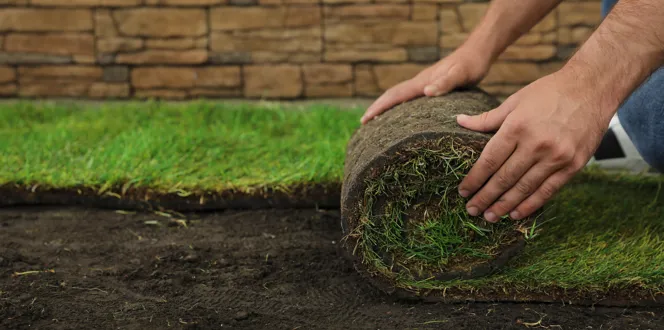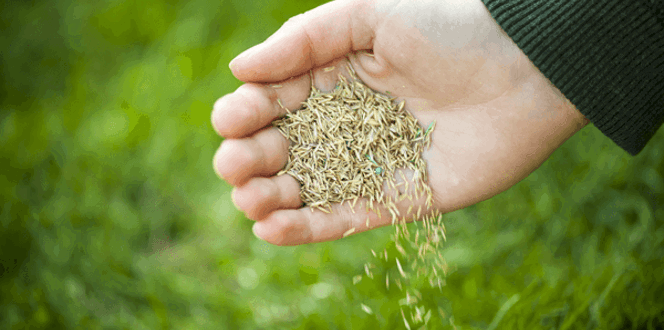As a homeowner, curb appeal is important to you. You want your home and yard to look nice. We understand that. Starting a new lawn is one part of completing this perfect landscape picture.
And, if you’re like us, once spring hits you can’t wait to get outside and get to seeding.
While we understand your hurry, you may want to stop for a minute to create a strategy that saves you time and money.
What magic trick can do this? It’s not magic. It’s science. Timing is actually a crucial component in how to seed a yard.
Why Timing is Important
You’ve got schedules to manage. A work schedule. Your children’s schedules. These schedules keep you focused throughout your day.
Similarly, your lawn has a schedule. Depending on your location, it goes through various phases in its year.
As a result, there are some ideal times that make planting new grass more successful than others, depending on your grass growing region and the type of grass you want to grow.
Generally, lawns in the northern half of the U.S. contain cool-season grasses like Kentucky bluegrass, tall fescue, or perennial ryegrass. And lawns in the southern half of the U.S. are typically warm-season grasses, such as St. Augustinegrass, Bermudagrass, Zoysiagrass, centipedegrass and Bahiagrass.
If you’re growing new grass based on its optimal growing period, you can maximize your seed germination rate, which means less waste and a thicker lawn.
Start with finding out what zone you are in (based on the USDA Plant Hardiness Zone Map). Then, choose a grass that grows well there and follow suggested best times to plant.
Use this general guide based on grass type:
- Bahiagrass - warm-season, USDA zones 7 to 11, plant in spring/summer
- Bentgrass - cool-season, USDA zones lower 4 to 6, plant in spring or fall (fall is best)
- Bermudagrass - warm-season, USDA zones 7 to 10, plant March through August
- Bluegrass - cool-season, USDA zones 2 to 6, plant February to May and September to November
- Buffalograss - warm-season, USDA zones 5 to 8, plant in spring
- Carpetgrass - warm-season, USDA zones coastal 8 to 9, plant in spring/summer
- Centipedegrass - warm-season, USDA zones 7 to 10, plant in spring/summer
- Fescue (tall) - cool-season, USDA zones 4 to 7, plant spring or fall (fall is best)
- Fescue (creeping red) - cool-season, USDA zones 3 to 7, plant spring or fall (fall is best)
- Ryegrass (annual) - cool-season, all USDA (seasonal), plant in fall
- Ryegrass (perennial) - cool-season, USDA zones 3 to 6, plant in spring or fall (fall is best)
- St. Augustinegrass - warm-season, USDA zones 8 to 10, plant in spring April to August (Available as sod, plugs or sprigs; not available as seed.)
- Zoysiagrass - warm-season, USDA zones lower 5 to 10, plant in spring April to August.Most zoysiagrass varieties are available as sod; some are available as seed.)
One additional consideration comes up when growing new grass if you happen to live in the transition zone of the country. This area blends northern and southern weather patterns and is roughly defined as the central eastern portion of the country, that overlaps various growing regions from the Atlantic coast to eastern New Mexico. Here, you may be using both warm- and cool-season grasses because almost no grass type is well-adapted for this region, with the exception of Tall Fescue.
When to Plant Grass Seed in Spring
Warm-season grasses are best planted during the spring and early summer.
You want to wait until daytime temperatures are consistently 65 degrees Fahrenheit or higher and all danger of late spring frost in your area has passed.
Pros to Plant Grass Seed in Spring
Spring planting allows warm-weather grasses to get the benefit of warm temperatures that come with summer while giving them time to establish before cooler weather in fall.
Cons to Plant Grass Seed in Spring
While spring has the advantages of cooler temperatures, conditions can get hot and wet very quickly. This means disease and drought can take advantage of a new lawn quickly.
You are also competing with weeds for space. Tender, new lawn blades may not be strong enough or thick enough to keep weeds from sneaking in, and you won’t be able to apply broadleaf/grassy weed pre-emergent herbicides. This will inhibit the germination process of newly planted seed.
When to Plant Grass Seed in Fall
It’s best to plant cool-weather grasses in the fall.
This is because they don’t have to deal with the scorching heat of the summer. Additionally, the grass has a chance to germinate and then go dormant into winter, building up essential nutrients. Then, in spring as grasses come out of dormancy, they continue to fill in, using these built up nutrients to thrive.
Pros to Plant Grass Seed in Fall
There are numerous pros to starting a new lawn in the fall.
- You avoid summer heat and dryness.
- Grasses store nutrients over fall and winter, priming themselves for optimal spring growth.
- Not as much weed or disease pressure.
Cons to Plant Grass Seed in Fall
The biggest con to planting grass seed in the fall is you don’t get to enjoy your new lawn right away since you’re going into winter.
But if you can handle delayed gratification, your lawn will thank you with a thick, green stand come spring.
How Much Do I Need to Water My New Grass?
Once you’re done seeding a new lawn, you want to keep that area evenly moist.
What this means depends on your soil type. If your soil is heavy clay, it’ll take longer to saturate than sandier soil. Water each section after planting new grass to get the water down an inch or two into the soil. Your goal is to keep the seeds moist -- not submerged -- at all times.
When you’re thinking about watering, pay attention to weather conditions. If your seed dries out during the day and there’s no rainfall, you’ll need a second watering each day to ensure consistent moisture until those seeds germinate. This takes about 10 to 14 days.
Once the seed germinates, you can reduce watering to once a day for 20-30 minutes until your lawn is established.
Many times, people will water right away until germination, but then they stop watering, thinking the job is done. Don’t neglect irrigation until those last seeds germinate and tender lawn shoots have a chance to grow strong. This can greatly improve your seed germination rate.
How Soon Can I Mow After Planting New Grass?
Weekly mowing during the growing season is an essential part of establishing and maintaining a thick, green lawn. This thriving grass stand can better withstand weeds and provide your home with great value.
After planting a new lawn from seed, you’ll want to wait to mow until most seeds have germinated. It’s important to not remove more than 1/3 of the leaf blade at any mowing, use heavy equipment,or mow when the soil is wet to protect the new seedlings.
Once this time has passed, mowing will continue to help your lawn grow. Remember not to collect the clippings and let them fall on the ground. This recycles important nutrients and any leftover seed your mower may have picked up back into the soil where they are most beneficial.
When Can I Use Weed Control on my New Grass?
When you’re growing new grass, you want to create an ideal environment for seed to germinate. Naturally, weeds may want to join the party. But they aren’t invited!
In your quest for a weed-free lawn, it’s important that you don’t use any preventive or curative weed control products until you’ve mowed your newly planted grass about two to three times -- or approximately four to six weeks after seeding. This ensures you give your seeds the chance to germinate and the lawn to establish itself.





